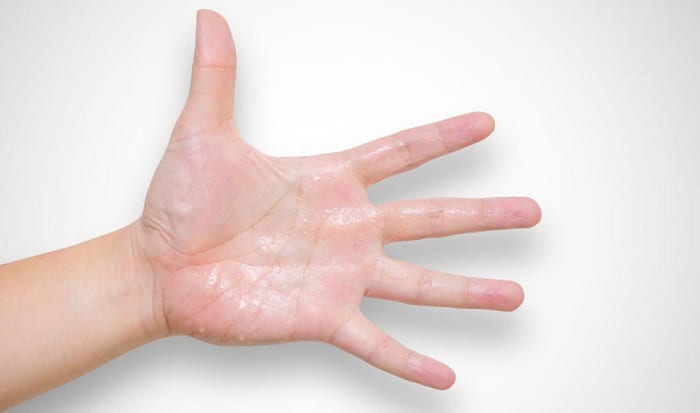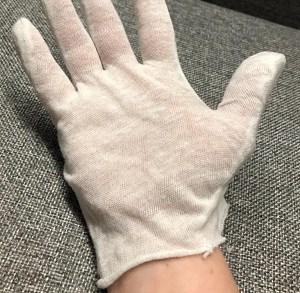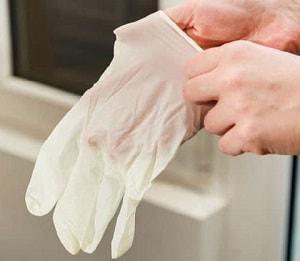Sweat glands, warm temperature, and enclosed space are not exactly a good combination for those of us who wear gloves for work. Our bodies perspire, and this is just a fact of life.
Once the sweat gets trapped inside the shoes, socks, or gloves, it can feel uncomfortable. But what’s different about sweaty hands in gloves is that it often causes the material to slip and slide. This, in turn, affects the way we hold our instruments.
How to put on gloves with sweaty hands? Let me share with you some techniques that other workers swear by.
Table of Contents
What You Need
Below, I included different items that you will need to prepare in addition to the gloves.
Note that the materials are generally applicable to disposable, utility, and fashion gloves unless otherwise specified.
- Cold water and soap
- Cotton gloves
- Ethanol, corn starch, baking soda, or talc
Step-by-step Guide
Technique #1: Cold Water and Soap
It is difficult to put on latex gloves with sweaty hands. However, nurse Fiona Tunsall shares on this Quora thread that if you need to wear gloves for healthcare purposes, washing your hands is preferable over applying talc.
Washing your hands with soap and cold water not only cleans them but also helps in sweat reduction.
To do this, follow these instructions:
Step 1: Soak your hands in clean cold water then apply the soap. In this way, you can work up a lather and spread it across your hands easily.
According to the Centers for Disease Control and Prevention (CDC), a good lather creates “micelles,” which eliminates germs, harmful chemicals, and dirt.
Step 2: Scrub your palms, fingers, and the areas between them, as well as the back of your hands. Do this for 20 seconds.
Setting a timer can be a hassle. Counting 1 to 20 is not always accurate. In this case, the CDC suggests humming the Happy Birthday song twice.
Step 3: Rinse your hands with cold water and dry them thoroughly with a towel or paper towel. Once your hands are free of moisture, you can don gloves.
Technique #2: Glove liner or cotton gloves
Normally, cotton or fabric gloves are worn to prevent skin oils and sweat from getting onto delicate surfaces. It also makes it easy for us to wear surgical gloves when our hands are sweaty.
Alternatively, this article from Bitesize Bio suggests wearing glove liners or fabric gloves for sweaty hands. It makes complete sense since certain textiles can absorb or wick away moisture.
Step 1: For this technique, select fabric gloves that are on the thinner side. You can pair them with slightly bigger surgical gloves.
Make sure your hands are clean by following the handwashing guide I shared above. After that, you can wear your everyday gloves for sweaty hands.
Step 2: Once you have donned the fabric gloves, wear your surgical gloves over your gloved hands.
If you are a visual learner, I recommend watching this short video by The Massage Doctor.
Technique #3: Using ethanol, corn starch, baking soda, or talc
If there is one thing ethanol, corn starch, baking soda, and talc have in common, it is that they can reduce sweat. Luckily, they are all available in drug stores and groceries.
Sweaty hands and gloves don’t mix well but you can reduce the moisture on your hands with ethanol, corn starch, baking soda, or talc.
Step 1: Begin by washing your hands with mild soap and cold water using the technique I just shared. Be sure to dry your hands thoroughly.
Step 2: Choose between ethanol, corn starch, baking soda, and talc. Next, apply one of these products to your hands by rubbing them together. Then, wear your gloves.
Other Solutions
If the methods above did not work for you, don’t fret; there are other steps that you can take.
1. Opt for thinner gloves or a bigger glove size
Though recommended by Bitesize Bio, let me preface by saying that thinner surgical gloves or bigger glove sizes are not recommended for jobs that require heavy protection.
Remember, the goal is to avoid contaminating your hands. Wearing glove sizes that are larger than your actual hands can create an opening for bacteria or harmful chemicals to enter.
If your task does not expose you to these contaminants, then you can wear thinner gloves or bigger sizes. This way, you don’t trap heat as much as you normally would with regular gloves.
2. Iontophoresis
Hyperhidrosis is a condition where one has overactive sweat glands, which causes excessive perspiration. It could be in your genes or connected with a medical condition or medicine that you take. In any case, palmar hyperhidrosis is specific to your hands.
Iontophoresis, on the other hand, is a treatment for those who are diagnosed with palmar hyperhidrosis. Think of it as “shutting down” your sweat glands according to Web MD.
Using a medical device, a mild electrical current will be sent through water where your hands are submerged. Sweat Help says that this treatment is usually employed when antiperspirants and other methods fail to work.
Conclusion
Regardless of the method, the first step of how to put on gloves with sweaty hands is to ensure your hands are not sweaty. Besides developing hygiene problems, you can never hold your tools properly when your gloves are sliding on your wet hands.
While I shared several ways for you to resolve the issue on your own, it is also worth considering seeing a doctor if you notice you are perspiring more than usual. For sure, medical professionals can give you longer-term solutions.

Veronica is our content editor. She is a talent in delivery. Her main work is editing and writing articles that are both informative and simple to follow. She is in charge of synthesizing our understanding of what personal protection equipment (PPE) is needed in each job, how to best apply it, and how to visualize that equipment.






